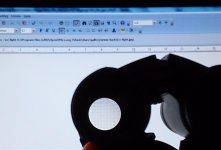Pinewood
New York correspondent

Hello all,
I bought a Meopta 6.5x32 MeoPro, last May, for $240, which makes it a low cost binocular. In part, i was interested because I used to use a Meopta enlarger, in the days of analogue chemical photography, as well as their enlarging lenses, I also have a Czech, probably a Meopta, military 6x30. . I have a relatively modern 6x glass, a Eagle Optics Ranger, as well as old6x Porro glasses, and two 7x binoculars, a Zeiss 7x42 Classic, a very nice binocular, and a Zen-Ray ED2, which never pleased me: the edges were fuzzy and the finish was a little lacking, as one eyepiece was higher than the other. The manufacturer describes it on their web site.
My first impression of the binocular was positive. It has the look and feel of a well made binocular. A little examination showed some interesting features. The dioptre scale is on the axle while the setting is made with a lug, at the same location, using rather quiet click stops. Another surprise is that the binocular was assembled in the USA.
The focussing knob is nice and big, requiring a tiny bit of effort to move. It moves with a little slop, when changing direction and it does not feel like my Zeiss or Leica binoculars, but they cost a lot more. I used it in -5ºC, and it was a little stiffer. In comparison my Zen-Ray is much stiffer.
When I first used it, in the field, I was dismayed by blackouts. I wear glasses, so I usually just put the eyecups all the way down. This binocular specifies an eye relief of 22.3 mm. I had to move the cups up to the first detente, which solved that problem. The field of view is stated at a very respectable 432 ft, at a 1,000 yards, 8.25º. However, with its specified 6.4 magnification, I find the apparent field of view, a bit tight, but hardly constrained.
I do not use charts or triplers, when judging resolution. I think it has sufficient resolution and contrast for its purpose. The edges are not sharp to the edges, but sharp enough for picking up a bird or other target: soft rather than fuzzy, but useful for almost the whole field. Incidentally, I maintain that it is impossible for a binocular to deliver the same center sharpness to the edge, unless you “stop” the lens down. I did not notice any color fringing, even on an overcast day probably because the objective does not have a short focal length, and I am not particularly sensitive chromatic aberration. There seemed to be a bit of field curvature, if one looked for it. I did not notice any pincushion distortion.
A very strong point is that the binocular is really excellent at preventing veiling glare. Looking at a full moon, there were no ghost images. It is a bit disappointing at internal reflections, when pointed near the sun. This was seen as glare or a reflection, at the edge. I bought some Vortex lens hoods, which mitigated the glare appreciably, I find this to be poor design. Either there is some internal reflection or the lenses should have been recessed. My guess is that the designers did not want to lengthen the body, which is fairly long. Early mornings in mid-November enjoy a very low sun, which was the source of the problem. I recall a similar problem with the 8x30 Zeiss Classic. I can easily imagine this to be a “deal breaker,” for many.
A problem for me, as an eyeglass wearer, are stray reflections off the eyepiece, when there is strong side or backlighting. My guess is that there is no problem for those who do not wear specs, as the problem disappeared when I took of my specs and raised the eyecups. Unfortunately, without my specs, the binocular cannot focus to infinity and my own astigmatism come into play. Incidentally, I had the same problem with the highly praised Nikon SE 8x32. In any case, cupping the hand on the sunlit side worked well, in the early autumnal morning.
The body has some ridges, which might help with the grip. The kit includes a case, which is tight fitting, and may not work, at all IPD settings, and only one strap, which I think was made for the case, not for the binocular. That was no problem for me, as I have spares, in my home. The objective covers and the rain guard are just right.
It is probably very suited for sylvan observations, or if one has trouble holding a binocular steady. The 5 mm exit pupil should be adequate for daytime use, even in heavy canopy. It actually performed reasonably well across Central Park Lake in distinguishing among shovellers, mallards and wood ducks. On the other hand, the other day, I needed more “reach,” when trying to identify a diving duck. It may not be particularly suited for identifying warblers, from a distance. It is a bit big for either the opera or for the theatre, but it is probably well suited for sports arenas.
However, as a bird watching glass, it may work very better when used with a 10x32, which is what I did, this week. Strangely, there were few situations, this week, when I wanted to switch to the 10X. Today in particular, I never had a situation where I had trouble distinguishing among, ducks or otherwise wanted more detail. I did switch to a 10x, when I wanted a more detailed look at a great blue heron and to make certain of some shovellers across the Reservoir.
Happy bird watching,
Arthur Pinewood :scribe:
I bought a Meopta 6.5x32 MeoPro, last May, for $240, which makes it a low cost binocular. In part, i was interested because I used to use a Meopta enlarger, in the days of analogue chemical photography, as well as their enlarging lenses, I also have a Czech, probably a Meopta, military 6x30. . I have a relatively modern 6x glass, a Eagle Optics Ranger, as well as old6x Porro glasses, and two 7x binoculars, a Zeiss 7x42 Classic, a very nice binocular, and a Zen-Ray ED2, which never pleased me: the edges were fuzzy and the finish was a little lacking, as one eyepiece was higher than the other. The manufacturer describes it on their web site.
My first impression of the binocular was positive. It has the look and feel of a well made binocular. A little examination showed some interesting features. The dioptre scale is on the axle while the setting is made with a lug, at the same location, using rather quiet click stops. Another surprise is that the binocular was assembled in the USA.
The focussing knob is nice and big, requiring a tiny bit of effort to move. It moves with a little slop, when changing direction and it does not feel like my Zeiss or Leica binoculars, but they cost a lot more. I used it in -5ºC, and it was a little stiffer. In comparison my Zen-Ray is much stiffer.
When I first used it, in the field, I was dismayed by blackouts. I wear glasses, so I usually just put the eyecups all the way down. This binocular specifies an eye relief of 22.3 mm. I had to move the cups up to the first detente, which solved that problem. The field of view is stated at a very respectable 432 ft, at a 1,000 yards, 8.25º. However, with its specified 6.4 magnification, I find the apparent field of view, a bit tight, but hardly constrained.
I do not use charts or triplers, when judging resolution. I think it has sufficient resolution and contrast for its purpose. The edges are not sharp to the edges, but sharp enough for picking up a bird or other target: soft rather than fuzzy, but useful for almost the whole field. Incidentally, I maintain that it is impossible for a binocular to deliver the same center sharpness to the edge, unless you “stop” the lens down. I did not notice any color fringing, even on an overcast day probably because the objective does not have a short focal length, and I am not particularly sensitive chromatic aberration. There seemed to be a bit of field curvature, if one looked for it. I did not notice any pincushion distortion.
A very strong point is that the binocular is really excellent at preventing veiling glare. Looking at a full moon, there were no ghost images. It is a bit disappointing at internal reflections, when pointed near the sun. This was seen as glare or a reflection, at the edge. I bought some Vortex lens hoods, which mitigated the glare appreciably, I find this to be poor design. Either there is some internal reflection or the lenses should have been recessed. My guess is that the designers did not want to lengthen the body, which is fairly long. Early mornings in mid-November enjoy a very low sun, which was the source of the problem. I recall a similar problem with the 8x30 Zeiss Classic. I can easily imagine this to be a “deal breaker,” for many.
A problem for me, as an eyeglass wearer, are stray reflections off the eyepiece, when there is strong side or backlighting. My guess is that there is no problem for those who do not wear specs, as the problem disappeared when I took of my specs and raised the eyecups. Unfortunately, without my specs, the binocular cannot focus to infinity and my own astigmatism come into play. Incidentally, I had the same problem with the highly praised Nikon SE 8x32. In any case, cupping the hand on the sunlit side worked well, in the early autumnal morning.
The body has some ridges, which might help with the grip. The kit includes a case, which is tight fitting, and may not work, at all IPD settings, and only one strap, which I think was made for the case, not for the binocular. That was no problem for me, as I have spares, in my home. The objective covers and the rain guard are just right.
It is probably very suited for sylvan observations, or if one has trouble holding a binocular steady. The 5 mm exit pupil should be adequate for daytime use, even in heavy canopy. It actually performed reasonably well across Central Park Lake in distinguishing among shovellers, mallards and wood ducks. On the other hand, the other day, I needed more “reach,” when trying to identify a diving duck. It may not be particularly suited for identifying warblers, from a distance. It is a bit big for either the opera or for the theatre, but it is probably well suited for sports arenas.
However, as a bird watching glass, it may work very better when used with a 10x32, which is what I did, this week. Strangely, there were few situations, this week, when I wanted to switch to the 10X. Today in particular, I never had a situation where I had trouble distinguishing among, ducks or otherwise wanted more detail. I did switch to a 10x, when I wanted a more detailed look at a great blue heron and to make certain of some shovellers across the Reservoir.
Happy bird watching,
Arthur Pinewood :scribe:







